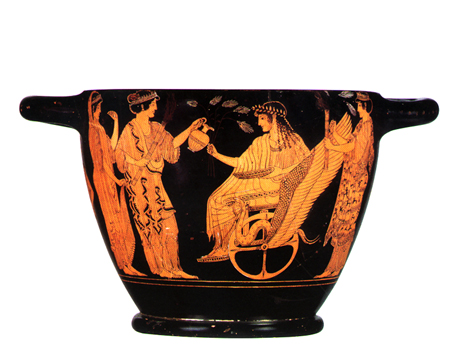Seated atop a winged chariot on this Red Figure ware Cotyle is the demigod, Triptolemos, who holds ears of corn. Facing him is Persephone, who holds a pitcher and a flaming torch. Behind her stands Eleusis, a personification of the city of Eleusis, site of the famed mysteries. Demeter is behind Triptolemos. Demeter, the goddess of agriculture assigned to Triptolemos the duty of instructing the Greeks in the secrets of agriculture. The lighted torches borne by Persephone and Demeter are symbolic of their yearly emergence from the underworld, where the torches lit their ways. Their emergence with the lit torches each year in spring represented the cycle of the seasons, in which spring signals the return of warmer weather and, in turn, the time to plant crops. Note that the human figure is represented in the same scale as that of the gods. In the Greek world, humans and gods interacted, and the Greeks viewed the gods as their protectors and intercessors. The rites of Demeter and her daughter, Persephone, took place at Eleusis, and were called the Eleusinian mysteries, secret rites which would guarantee a secure afterlife to its initiates. Great processions of initiates took place between Athens and Eleusis.
Attic Red-Figure was was created using a highly sophisticated firing procedure which involved alternating cycles of oxidation and reduction. While it appears that the red and black colors result from a painted application of the colored slip, the reality is quite different. After the piece was thrown on the wheel, and handles attached, a deflocculated slip (terra sigillata) was painted onto the surface in the area that will later become black, while the figures were left unpainted. The slip that was painted was the same color as the body slip. Only during the firing does the color change occur. The cotyle was fired in a kiln with adequate oxygen supply (oxidation) until nearly the end of the firing. At that point, the oxygen supply was cut back (reduction) and a smoky flame resulted. The smoke that was generated impregnated the clay, turning the entire vessel black. Next, the oxygen supply was reintroduced, and the clay began to return to its red color. The unpainted areas would return to red first, followed by the painted areas later. So, at the key moment in the firing cycle, the firing was stopped, just as the figure areas had returned to red, while the slip-painted, background areas, still remained black. Were the firing allowed to proceed too long, all areas would return to red, losing the contrast in the composition.

Triptolemos receives the secrets of agriculture from Persephone
Greek Red Figure Cotyle, 530-330 BCE


